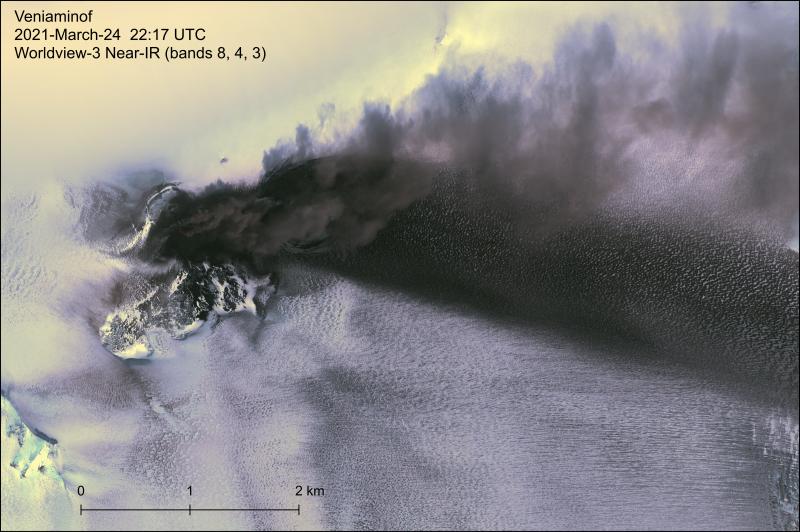
Worldview-3 near-IR satellite image of the Veniaminof eruption on March 24, 2021. Tephra deposits and an active ash plume are visible to the east of the summit cone. The 2018 lava flow field is visible south of the cone, while the 2021 lava flow ice cauldron is mostly obscured by the plume.
Volcano(es): Veniaminof
Photographer: Loewen, M. W.
URL: avo.alaska.edu/image/view/168851
Veniaminof 2021/2
Regional infrasound sensors detected a small explosion from Veniaminof volcano March 4, 2021 14:13 UTC (05:13 local time). Satellite and webcam views indicate low-elevation (< 10,000 ft asl) ash emissions heading in the SSE direction, and minor ash deposits are visible at the volcano. As a result, AVO raisedhe Aviation Color Code to ORANGE and the Volcano Alert Level to WATCH at Veniaminof volcano. The local seismic data remains offline due to an outage of a satellite link at Port Heiden. However, the Alaska Volcano Observatory continues to monitor Veniaminof with satellite and webcam data and remote infrasound, seismic and lightning networks.
By March 12, 2021, the eruption has produced ash emissions from the small cone in the summit caldera, in addition to lava effusion from a vent on the flank of this cone ~1 km (0.6 miles) east of the cone summit within the intracaldera glacier. Low-level plumes of volcanic ash have been observed at ~7,000-10,000 ft asl extending as far as 200 km (124 miles) downwind, leaving trace ash deposits within ~20 km (12.4 miles) of the vent to the northeast and southeast. Explosions corresponding to this activity have been detected on regional geophysical networks. Explosive activity declined March 10-12, with minor ash emissions only observed near the vent and no activity detected in regional geophysical data. No ashfall from this eruption has been reported in nearby communities. Retrospective analysis of satellite, web camera, and regional infrasound data has shown evidence that eruptive activity began by February 28, 2021, with minor ash emissions and a small melt pit forming in the glacier above the flank vent.
NextView license
Full Resolution.